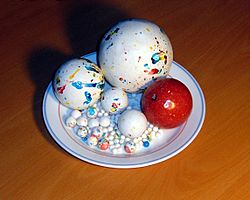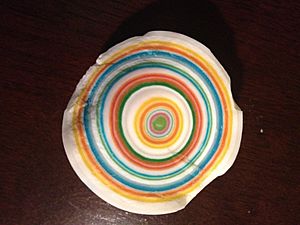Gobstopper facts for kids

Gobstoppers of various sizes and colours. The largest one is 3 inches (~7.5 cm) in diameter
|
|
| Alternative names | Jawbreaker, Jawbuster |
|---|---|
| Type | Confectionery |
| Place of origin | United Kingdom |
| Main ingredients | Sugar |
Gobstoppers are a super hard type of candy. In the United States, they are often called jawbreakers. These candies are usually round. They can be as small as 1 cm (0.39 in) or as big as 8 cm (3.1 in) across!
The name "gobstopper" comes from the word "gob." This is a slang word for "mouth" in the United Kingdom and Ireland. These candies were very popular with British schoolboys many years ago.
Gobstoppers have many layers. Each layer dissolves slowly in your mouth. As one layer disappears, a new, different colored (and sometimes different flavored) layer appears! They are so hard that you cannot bite them. Trying to bite a gobstopper could hurt your teeth! That's why they are called "jawbreakers."
These candies have been sold in sweet shops for over 100 years. They were often sold by weight from big jars. Gobstoppers dissolve very slowly. This means they last a long time in your mouth. This is a big reason why kids love them so much! Really big gobstoppers can even take days or weeks to fully dissolve.
How are Gobstoppers Made?
Gobstoppers are made by adding layers very slowly. They start with a small center, like a pressed sugar ball. Sometimes, the center is even a gumball.
The candies are made in large, spinning, warm pans. This special way of making them is called "hot panning." It takes several weeks to make gobstoppers. This is because liquid sugar is added many times, layer by layer. Different colors and flavors are also added during this layering process.
The Everlasting Gobstopper
The Everlasting Gobstopper is a famous candy. It is sold by Nestlé's Willy Wonka Candy Company. This candy was first made in 1976.
It is named after the magical Everlasting Gobstoppers in Roald Dahl's famous children's book, Charlie and the Chocolate Factory. In Roald Dahl's story, these special gobstoppers were supposed to last forever! Roald Dahl named his fictional candy after the real gobstoppers. These were a favorite treat for British schoolboys between the two World Wars.
Images for kids



